|
March 1948 Popular Science
 [Table of Contents] [Table of Contents]
Wax nostalgic about and learn from the history of early
electronics. See articles from
Popular
Science, published 1872-2021. All copyrights hereby acknowledged.
|
This article is a good indicator
of how prevalent cigarettes were back in 1948 when it appeared in Popular Science
magazine. Transmitter, receiver, and hearing air amplifiers were referenced to be
"about the size of a pack of cigarettes." The peanut vacuum tubes used within are
said to be "smaller than a half-smoked cigarette." Those of us who lived back in
the days when smoke-filled restaurants, buses, grocery stores, and houses was the
norm easily compare the sizes to such a familiar entity. We even know what it means
to be "smaller than a bread box." Nowadays, references to the size of electronic
components would be to something like a grain of sand, which is a form of irony
since that's what the chip is made from (essentially). The article's title, "The
Radio That Was Shot from a Gun," derives from the miniaturization technology developed
for anti-aircraft shell proximity fuses.
Coming - The Radio That Was Shot from a Gun
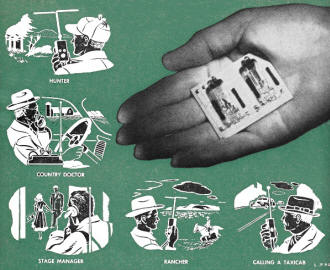
The tiny elements used in a great war invention are now ready
to go to work in civilian transceivers.
By Harland Manchester
Carrying a complete broadcasting station in the palm of his hand, a radio engineer
walked out of his laboratory at the Bureau of Standards in Washington the other
day, talking as he went down the stairs and out of the building. His voice came
to us from a loudspeaker in the room he had left, as clearly as if he were still
there. His transmitter, containing microphone, tubes, circuits, batteries, and aerial,
was enclosed in a plastic box about the size of a pack of cigarettes.
This is one of many types of subminiature radios, developed at the Bureau of
Standards and elsewhere as a result of wartime research, which a dozen manufacturers
will soon offer to the public. There are receiving sets the size of a fat wallet,
which pick up standard radio programs, and two-way radio sets to be carried by a
shoulder strap like a camera. In the Bureau's laboratories there are short-range
broadcasting stations the size of a lipstick, with certain tubes little larger than
a grain of rice, and other transmitters about as large as a thick powder compact,
which can be worn on the wrist, with midget batteries concealed in the strap.
These amazing little radios were sired by one of the most devastating new weapons
of World War II - the proximity fuse. This is a radar-like device, mounted in the
nose of an artillery shell, which detected the presence of enemy planes and caused
the shell to explode if there was a plane within a radius of 70 feet. Before its
use, anti-aircraft fire was notoriously ineffective. In the Battle of Britain, it
took 2,500 shells, with good marksmanship, to bring down one German plane. British
and American scientists conceived the seemingly impossible notion of sweating down
a radio sending and receiving station into a space the size of an ice-cream cone,
so that it would fit into the nose of a shell. This ambitious project was carried
out by the Office of Scientific Research and Development, with Dr. Merle A. Tuve
heading a group that included many of the country's leading physicists and corporation
representatives.
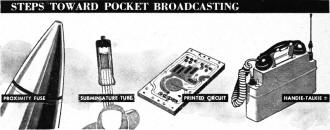
Fuse fathered tiny tube and printed circuit; Handie-Talkie™
presages pocket transceiver.
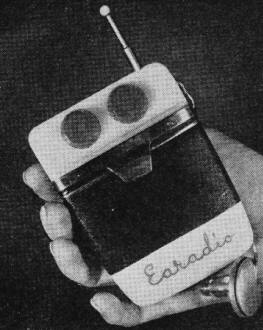
This Earadio™ weighs 8 1/4 oz., measures
3 1/8 by 4 3/10 by 1 3/4, inches. Retractable antenna is on top, earplug is metal
disk at bottom. It is made by Masterpiece Radios, Inc.
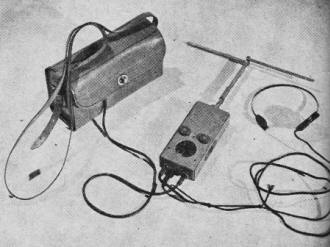
Ultraphone Citizens Radio™ is transceiver
designed for FCC's forthcoming Citizens Radio Service. Six inches high, it weighs
2 1/4 lb. with batteries. Folding dipole antenna plugs into top.
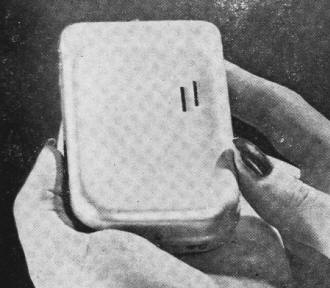
The Solo-Pak™ is one of the tiniest single-unit
hearing aids yet devised. It uses new printed circuit, smaller than a playing card
and only 3/32 inch thick, claims greater efficiency.
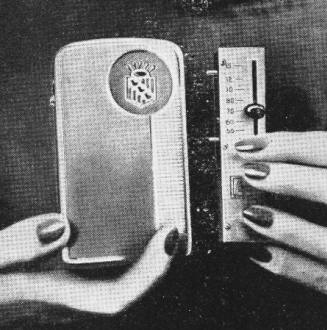
The Acousticon Radion™ combines a tiny
hearing device with an even tinier radio, shown at right. Radio simply plugs into
the side of the aid, imposes no extra battery strain.
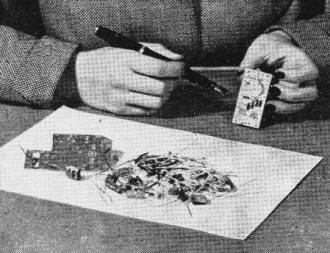
The tiny ceramic wafer at right is the printed
circuit developed by Allen-Howe Electronics Corp. for their Solo-Pak™ aid.
It replaces the 173 items jumbled together in the foreground.
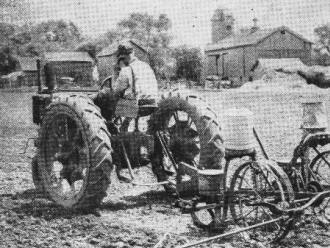
The Handie-Talkie™, developed by Motorola,
enables a farmer to radiophone right from his tractor. An FM transmitter-receiver,
the 8 1/2%-lb. unit is designed for the 25-44-mc. band.
Tubes Tiny But Tough
Sturdy little radio tubes smaller than a half-smoked cigarette were already being
made for hearing aids. These were made still smaller, and so strong that they could
be fired from guns at a force 20,000 times that of gravity without breaking the
glass walls or the fine filaments. Before V-J Day, 130,000,000 of these tubes had
been made by Sylvania Electric Products, Inc., and other firms, and the cost had
approached that of many standard tubes.
Rugged miniature batteries of new design were also developed, and the parts were
cleverly assembled in the incredibly small space. The result was one of the greatest
advances in modern warfare. For the first time in the history of fighting planes,
anti-aircraft fire became effective. German V-1s and Japanese Kamikazes triggered
the shells as they came within range of the tiny radios and were blown to bits.
Entire German battalions were wiped out in the Battle of the Bulge as proximity-fused
shells exploded at a lethal distance above ground, making shelter futile.
A further development, which came late in the war, was the printed circuit. Look
in the back of your radio and you will see a baffling maze of wires strung in place
laboriously by hand. This has long been one of the bottlenecks of radio manufacture.
So, using an idea that had been hanging around for years, engineers of the U. S.
Bureau of Standards and Globe Union, Inc., of Milwaukee, learned how to print, stamp,
or stencil the wiring on thin plastic or ceramic sheets. Little lines made of thick
silver ink carried the current through its paths, and an ink containing powdered
carbon was used for resistance circuits.
This process has been perfected to the point where the circuits of a miniature
radio set can be printed on a bit of plastic the size of a calling card. These circuits
perform as well as wired circuits, and are less likely to get out of order. As an
ultimate refinement of miniaturization, the wiring has actually been etched on the
little glass tube itself.
It cost America $800,000,000 to develop and produce this epochal weapon. Since
the war, Dr. Cledo Brunetti and half a dozen co-workers of the Bureau of Standards
have spent their spare time converting the radios that were shot from guns into
sets for civilian use, and a large section of the industry is tooling up to build
them. Soon we are to get returns on our investment, in the form of pocket radios
with a thousand and one uses. And in a few years the midget tube and the printed
circuits, built into everyman's radio, should cut its size, weight, and cost, and
make repair jobs easier.
Ear Aid First to Use New Printed Circuit
The first printed-circuit device to reach the market is a six-ounce hearing aid
little larger than a cigarette pack. The makers, Allen-Howe Electronics Corp., of
Peabody, Mass., achieved this result by boiling down the 173 items of the old amplifying
system, including wires, screws, soldered joints, and tube sockets, so that it could
be mounted on a printed ceramic wafer about half as big as a graham cracker.
Using the tiny tubes, printed circuits, or both, three firms, Raytheon, Masterpiece
Radios, and Modernair, will soon bring out pocket radios that will pick up standard
broadcasts. As highly styled as cigarette or vanity cases, they measure about three
by five inches, and an inch or less thick, and weigh as little as nine ounces complete.
These personal portables have earplugs attached to thin wires, and are no more conspicuous
in use than hearing aids. They have the usual knobs for tuning and volume control.
Estimated prices range from $20 to $65. They will probably become popular as deluxe
gifts for travelers.
Many firms are rushing light, portable transceivers, as two-way radios are called,
for the new Citizens Radio Service, an exciting field of communications that should
be ready for the public soon. Three years ago the Federal Communications Commission,
spurred by the zeal of Commissioner E. K. Jett, set aside the new radio band for
any citizen, firm, or organization to use in transmitting business or personal messages.
Over this band the doctor can talk with his office, the reporter with his city editor,
the husband with his wife, or the hunter can ask the boys at the camp to come and
help him bring in a deer.
Among the few restrictions: paid messages cannot be sent, programs cannot be
broadcast, and licenses to use sets will not be issued to aliens. All users will
be licensed at no cost. Since the band (460-470 megacycles) is in the ultra-short-wave
part of the radio spectrum, transmission is roughly limited to line-of-sight. This
means that while a fire watcher on a mountaintop or a passenger in a plane might
talk with someone 100 miles away, surface communication would be limited to about
five miles.
Several hundred two-way portables are now being tested experimentally by police,
firemen, geologists, and motion picture producers. Because of the narrow band allotted,
not more than 50 conversations can take place at once in anyone area. But if users
wait for the other fellow to finish, as they do on a party line, everyone in a town
of 1,500 who wants a set should have ample time on the air.
Scores of practical jobs are being proposed for the new service. The Gross Electronics
Corporation, of Cleveland, is making a two-and-a-quarter-pound set to be carried
by shoulder strap like a small camera, and reports that a newspaper has ordered
sets for reporters. A steel firm wants it. for interplant communication by peripatetic
foremen, inspectors at a railway food terminal wish to try it out for making reports
on the condition of carloads of produce, and the ground keeper of a big cemetery
wants a set for reporting the condition of graves.
The military type of "walkie-talkie" was once used by a group of hunters in closing
in on a bear; citizens' sets can be used in the same way. They should be of particular
value to guards and watchmen, foresters, ranchers, and lumbermen. Their use is foreseen
in coordinating activities of yacht fleets, motor caravans, parades, and county
fairs, and for emergency communication systems when storms and floods knock out
phone service. Owners of small private planes will probably use them for ground
communication, and, of course, a lot of people, like the boys on the amateur band,
will use them just for fun.
A good example of the value of short-range radio can now be seen at Lake Success,
where proceedings are speeded up 50 percent by light portables passed out to delegates.
Speeches are translated and broadcast simultaneously in English, French, Russian,
Spanish, and Chinese. Delegates tune in on their own wave lengths, and can leave
the room without missing anything. It would be technically possible to set up telephone
relay stations so that people at public gatherings or on beaches could make calls
via pocket radio.
Smaller Tubes Mean Lighter Planes
Tiny radios are only one result of the great wartime project. General Electric
engineers predict that in a few years a large transport plane will carry more than
600 electronic tubes, which at present weigh 225 pounds, while the same number of
miniature tubes tip the scales at 37 pounds. Space is also saved, and the tubes
are so sturdy that you can safely bounce them on the floor.
The new tubes, together with the printed circuits, seem destined to usher in
a revolution in radio sets and other electronic devices. By printing or stenciling
the wiring circuit on a plate, one workman can turn out about 500 circuits in the
time it now takes him to wire one set. There are about a hundred soldering operations
in the average household radio set; printed circuits may eliminate half of these
jobs, with important savings in labor and materials.
A plastic block on Dr. Brunetti's desk, resembling a paperweight, gives a further
glimpse of the radio of tomorrow. This is the new "potted" radio developed at the
Bureau of Standards. Circuits and tubes are embedded in a special plastic like flies
in amber, to protect them from shock, moisture, and mildew. Plug the protruding
wires into loudspeaker, tuner, and light socket and you have a working radio.
It may be some time before all these developments are adopted by the radio industry,
but all signs point to smaller, cheaper, more durable sets composed of a few simple
parts that anyone can plug together. Today you can buy a radio for $30 that will
outperform the $200 set you bought in 1927. This was brought about largely by simplified
manufacturing processes. Now engineers see an even greater transformation on the
horizon.
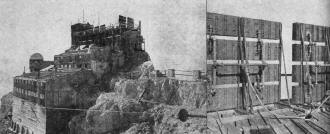 Aerie Houses Relay Aerie Houses Relay
That's not a medieval castle perched up on a mountain peak, above left. It's
a wireless-telephone relay station on the top of the 9,738-foot Zugspitze, highest
mountain of the Bavarian Alps, near Garmisch, Germany. One of three between Munich
and Frankfort, the station has been released for German use and is manned by five
German technicians. At right, is a close-up of the rear of the station's antenna.
Posted April 12, 2024
|


















